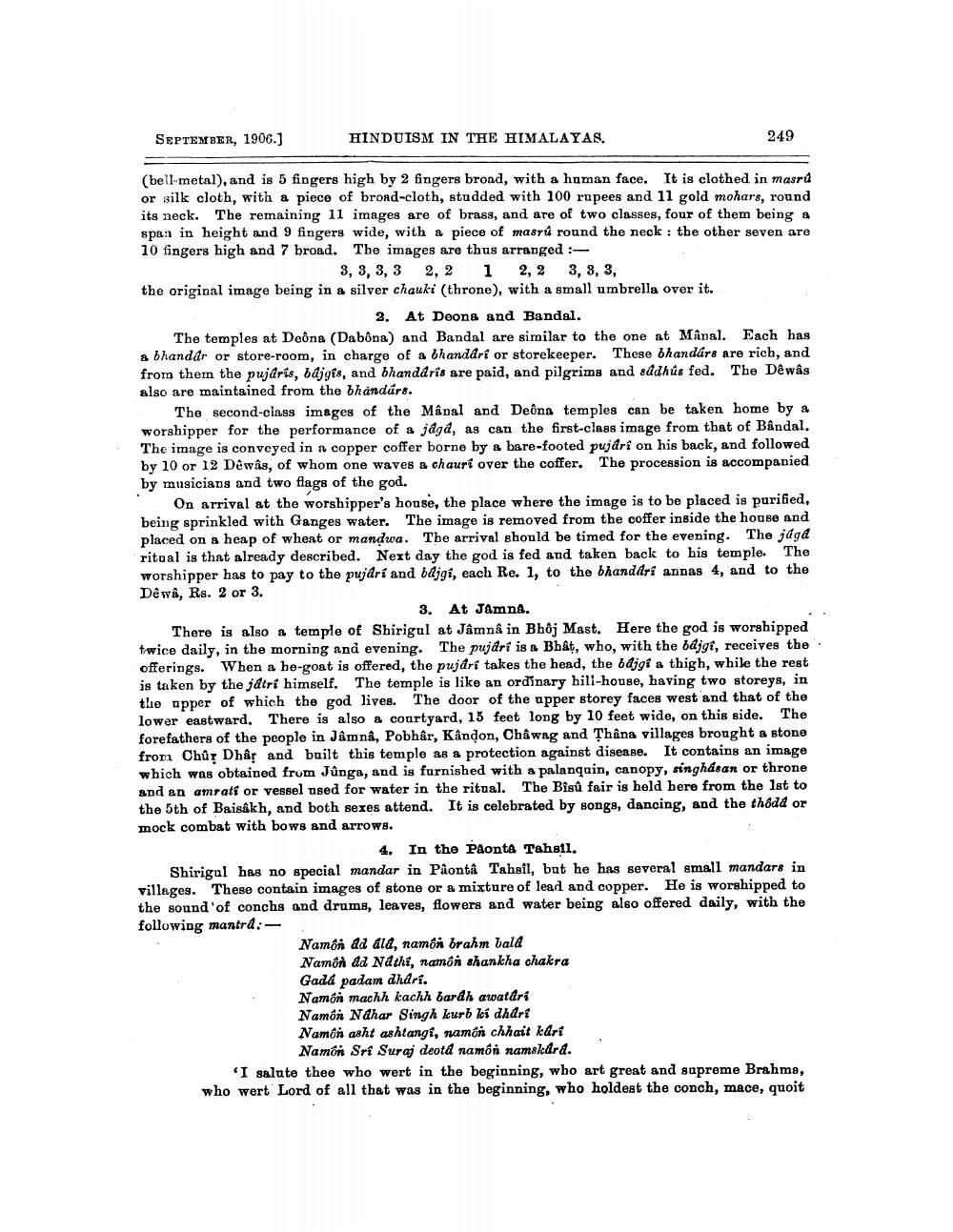________________
SEPTEMBER, 1906.)
HINDUISM IN THE HIMALAYAS.
249
(bell-metal), and is 5 fingers high by 2 fingers broad, with a human face. It is clothed in masra or silk cloth, with a piece of broad-cloth, studded with 100 rupees and 11 gold mohars, round its neck. The remaining 11 images are of brass, and are of two classes, four of them being a span in height and 9 fingers wide, with a piece of masrú round the neck : the other seven are 10 fingers high and 7 broad. The images are thus arranged :
3,3,3,3 2,2 1 2, 3, 3, 3, the original image being in a silver chauki (throne), with a small umbrella over it.
2. At Deons and Bandal. The temples at Doona (Dabona) and Bandal are similar to the one at Mînal. Each has a bhandar or store-room, in charge of a bhandari or storekeeper. These bhandárs are rich, and from them the pujdrís, bdjgis, and bhandarís are paid, and pilgrims and addhús fed. The Dewas also are maintained from the bhandárs.
The second-class images of the Mapal and Deôna temples can be taken home by a worshipper for the performance of a jága, as can the first-class image from that of Bandal. The image is conveyed in n copper coffer borne by a bare-footed pujari on his back, and followed by 10 or 12 Dewas, of whom one waves a chaurí over the coffer. The procession is accompanied by musicians and two flags of the god.
On arrival at the worshipper's house, the place where the image is to be placed is purified, being sprinkled with Ganges water. The image is removed from the coffer inside the house and placed on a heap of wheat or mandwa. The arrival should be timed for the evening. The jagd ritual is that already described. Next day the god is fed and taken back to his temple. The worshipper has to pay to the pujari and bdjgi, each Re. 1, to the bhandari anpas 4, and to the Dewa, Rs. 2 or 3.
3. At Jamna. There is also a temple of Shirigul at Jâmnâ in Bhôj Mast. Here the god is worshipped twice daily, in the morning and evening. The pujdrí is a Bhât, who, with the bdjgt, receives the offerings. When a he-goat is offered, the pujarí takes the head, the bdjgí a thigh, while the rest is taken by the jdtrí himself. The temple is like an ordinary hill-house, having two storeys, in the apper of which the god lives. The door of the upper storey faces west and that of the lower eastward. There is also a courtyard, 15 feet long by 10 feet wide, on this side. The forefathers of the people in Jamna, Pobhâr, Kândon, Châwag and Thâna villages brought a stone from Chûr Dhâr and built this temple as a protection against disease. It contains an image which was obtained from Jùnga, and is furnished with a palanquin, canopy, singhásan or throne and an amratf or vessel used for water in the ritual. The Bisû fair is held here from the 1st to the 5th of Baisakh, and both sexes attend. It is celebrated by songs, dancing, and the thôdd or mock combat with bows and arrows.
4. In the Paonta Tahsil. Shirigul has no special mandar in Ponta Tahsil, but he has several small mandars in villages. These contain images of stone or a mixture of lead and copper. He is worshipped to the sound of conchs and drums, leaves, flowers and water being also offered daily, with the following mantra:
Namoi ad ala, namor brahm bald Namon ad Nathi, namôn shankha chakra Gadd padam dhari. Namốn machh kachh bardh awatari Namon Ndhar Singh kurb koi dhart Namon asht ashtangi, namón chhait kari
Namon Sri Suraj deotd nami namskdrd. I salute thee who wert in the beginning, who art great and supreme Brahma, who wert Lord of all that was in the beginning, who holdest the conch, mace, quoit




